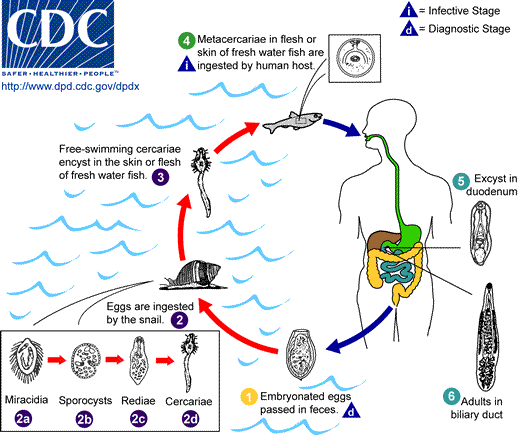| |
The adult flukes
deposit fully developed eggs that are passed in the feces
 .
After ingestion by a suitable snail (first intermediate host) .
After ingestion by a suitable snail (first intermediate host)
 , the
eggs release miracidia , the
eggs release miracidia
 , which
undergo in the snail several developmental stages (sporocysts , which
undergo in the snail several developmental stages (sporocysts
 , rediae , rediae
 ,
cercariae ,
cercariae
 ).
Cercariae are released from the snail ).
Cercariae are released from the snail
 and
penetrate freshwater fish (second intermediate host), encysting as
metacercariae in the muscles or under the scales and
penetrate freshwater fish (second intermediate host), encysting as
metacercariae in the muscles or under the scales
 . The
mammalian definitive host (cats, dogs, and various fish-eating mammals
including humans) become infected by ingesting undercooked fish containing
metacercariae. After ingestion, the metacercariae excyst in the duodenum . The
mammalian definitive host (cats, dogs, and various fish-eating mammals
including humans) become infected by ingesting undercooked fish containing
metacercariae. After ingestion, the metacercariae excyst in the duodenum
 and ascend through the ampulla of Vater into the biliary ducts, where they
attach and develop into adults, which lay eggs after 3 to 4 weeks
and ascend through the ampulla of Vater into the biliary ducts, where they
attach and develop into adults, which lay eggs after 3 to 4 weeks
 .
The adult flukes (O. viverrini: 5 mm to 10 mm by 1 mm to 2 mm; O.
felineus: 7 mm to 12 mm by 2 mm to 3 mm) reside in the biliary and
pancreatic ducts of the mammalian host, where they attach to the mucosa. .
The adult flukes (O. viverrini: 5 mm to 10 mm by 1 mm to 2 mm; O.
felineus: 7 mm to 12 mm by 2 mm to 3 mm) reside in the biliary and
pancreatic ducts of the mammalian host, where they attach to the mucosa.
|
|
